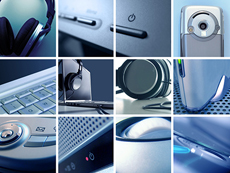Employing Technology in User Research
Armed with an up-to-date understanding of technological advancements and a creative thought process, we can innovate new and powerful ways of observing and studying user behavior—approaches that were completely impractical just a few years ago. Here are a few innovative ideas for improving user research methods in specific contexts, using technology that is cheap and at our fingertips.
- Attach a small digital video camera
 to a patient’s clothing—somewhere it isn’t noticeable—and record the patient’s interactions with a physician and other medical staff, then observe the raw footage of their interactions. Do the same with nurses and doctors and compare their different perspectives. Couple this data with patient journaling and follow-up interviews to better understand the difference between what a patient says and what actually happens. The value of this approach is the ability to see and hear the patient’s experience and search for patterns of discomfort that we could overcome, enhancing the user experience.
to a patient’s clothing—somewhere it isn’t noticeable—and record the patient’s interactions with a physician and other medical staff, then observe the raw footage of their interactions. Do the same with nurses and doctors and compare their different perspectives. Couple this data with patient journaling and follow-up interviews to better understand the difference between what a patient says and what actually happens. The value of this approach is the ability to see and hear the patient’s experience and search for patterns of discomfort that we could overcome, enhancing the user experience. - Attach a heart-rate monitor
 to a patient’s chest and record indications of stress or discomfort. You could either accompany a patient to observe a doctor’s visit or couple this approach with the video camera option we just described. The heart-rate data this approach lets you obtain can illuminate the points in the patient experience that cause stress, anxiety, or frustration—especially when you integrate this data with interviews. For example, if the greatest fluctuation in a patient’s heart rate occurred when the doctor entered the examination room to see the patient, a subsequent interview might reveal that the patient felt extremely anxious while waiting for the doctor, because he had no idea how long the wait would be. This information could lead to a redesign of the patient experience to include a visual report of the amount of time a patient would have to wait for a doctor or simply providing some distractions like games or a small television in the examination room to reduce the patient’s anxiety. This type of data can directly pinpoint opportunities for improving the user experience.
to a patient’s chest and record indications of stress or discomfort. You could either accompany a patient to observe a doctor’s visit or couple this approach with the video camera option we just described. The heart-rate data this approach lets you obtain can illuminate the points in the patient experience that cause stress, anxiety, or frustration—especially when you integrate this data with interviews. For example, if the greatest fluctuation in a patient’s heart rate occurred when the doctor entered the examination room to see the patient, a subsequent interview might reveal that the patient felt extremely anxious while waiting for the doctor, because he had no idea how long the wait would be. This information could lead to a redesign of the patient experience to include a visual report of the amount of time a patient would have to wait for a doctor or simply providing some distractions like games or a small television in the examination room to reduce the patient’s anxiety. This type of data can directly pinpoint opportunities for improving the user experience. - Have nurses wear a pedometer
 that records the number of steps they take during or between activities. For example, it might be interesting to learn how many steps a nurse takes when seeing a patient. A nurse might guide a patient to an examination room, then walk back to the nurses’ station to retrieve the equipment that’s necessary to obtain relevant diagnostic information. Perhaps, under certain conditions, a nurse might have to walk to the nurses’ station, then to a supply room to find something that’s not in common use. Such data would help you to understand how much time nurses spend walking between different exam rooms, doctors’ offices, nurses’ stations, and supply rooms—key information when redesigning their workspace to increase efficiency.
that records the number of steps they take during or between activities. For example, it might be interesting to learn how many steps a nurse takes when seeing a patient. A nurse might guide a patient to an examination room, then walk back to the nurses’ station to retrieve the equipment that’s necessary to obtain relevant diagnostic information. Perhaps, under certain conditions, a nurse might have to walk to the nurses’ station, then to a supply room to find something that’s not in common use. Such data would help you to understand how much time nurses spend walking between different exam rooms, doctors’ offices, nurses’ stations, and supply rooms—key information when redesigning their workspace to increase efficiency.
With a little creativity in our use of technology, we can gather data in ways that paint a more complete picture of an overall user experience. Using technology to gather data provides objective measures of people’s behavior, so can enhance our traditional subjective measures of user experience by allowing us to ask research participants about things we’ve noticed in the recorded data. For example, after looking at pedometer data, you might ask a nurse why she had to walk to a supply closet three times for a single patient.
These approaches should not replace more traditional ways of understanding user experience. Instead, we should use them to enhance our current research methods. Of course, these research approaches might be inappropriate in particular situations, and there might be times when they would prove to be unnecessary. However, even when they would be appropriate and could provide some value to our understanding of a user experience, there might still be potential roadblocks to implementing these kinds of approaches.
 As technology evolves and new gadgets and electronics emerge in the marketplace, our options for the use of technology in conducting our user research continue to expand. The processes through which we have long gathered data—such as surveys and interviews—are no longer the only ways in which we can understand people and how they respond to our clients’ products and services. As professional user researchers, we have the opportunity to devise new and innovative ways of more accurately understanding user experience through the use of technology. For example, consider the following user research scenario:
As technology evolves and new gadgets and electronics emerge in the marketplace, our options for the use of technology in conducting our user research continue to expand. The processes through which we have long gathered data—such as surveys and interviews—are no longer the only ways in which we can understand people and how they respond to our clients’ products and services. As professional user researchers, we have the opportunity to devise new and innovative ways of more accurately understanding user experience through the use of technology. For example, consider the following user research scenario:
